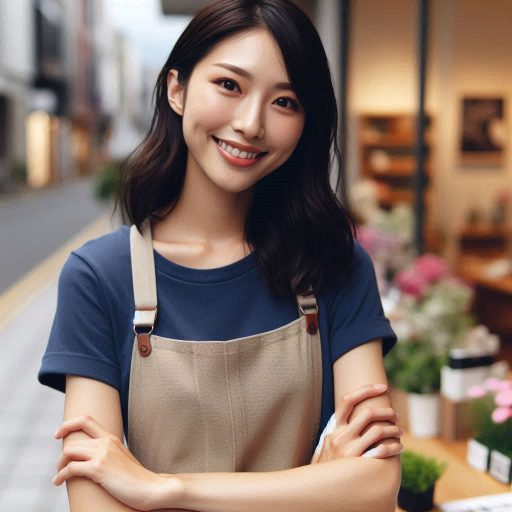Introduction
Designing for different body types is essential in fostering a more inclusive fashion industry.
It ensures that fashion accommodates a diverse range of shapes and sizes, rather than adhering to a one-size-fits-all approach.
Inclusive design goes beyond merely expanding size ranges; it involves creating clothing that fits and flatters various body types.
The impact of inclusive design on self-esteem and confidence is profound.
When individuals find clothing that suits their unique body shape, they feel more valued and accepted.
This representation in fashion allows people to see themselves as beautiful and worthy, which can significantly enhance their self-esteem.
Feeling represented in fashion encourages individuals to embrace their bodies with confidence, knowing that their shape is celebrated rather than marginalized.
By prioritizing inclusive design, designers contribute to a more positive and supportive fashion environment.
They help to break down conventional beauty standards and promote a broader, more accepting view of body image.
This approach not only empowers individuals but also inspires a more equitable fashion industry where everyone can feel confident and beautiful.
Understanding Different Body Types
Understanding different body types is crucial for designing clothing that fits well and flatters various shapes.
Recognizing the unique characteristics of each body type helps designers create garments that enhance comfort and style.
Here are the primary body shapes and how to identify them:
Body Shapes
Pear Shape
Individuals with a pear shape have narrower shoulders and a wider hip measurement.
Their lower body is fuller compared to the upper body.
This shape often has a defined waistline.
To highlight a pear shape, designers can use A-line skirts and tops that emphasize the waist while balancing the hips.
Apple Shape
An apple shape features broader shoulders and a fuller midsection with narrower hips.
The waistline may not be as defined.
Apple-shaped individuals often have slimmer legs.
Designers can create garments that draw attention to the legs and provide structure to the torso.
Flowy tops and tailored pants work well for this body type.
Hourglass Shape
An hourglass shape has balanced shoulders and hips with a well-defined waist.
This body type often features curves that are proportional.
To flatter an hourglass shape, designers should create clothing that accentuates the waist and highlights curves.
Fitted dresses and high-waisted skirts can enhance the natural shape.
Identifying Body Types
To accurately identify one‘s body type, start with measurements and observations.
Begin by measuring key areas: shoulders, bust, waist, and hips.
Compare these measurements to determine the proportions of each body part.
Shoulders and Bust
Measure around the fullest part of the bust and the shoulders.
This will help determine if the upper body is broader or narrower compared to the hips.
Waist
Measure the waist at its narrowest point.
This measurement helps to identify how defined the waistline is relative to the bust and hips.
Hips
Measure around the fullest part of the hips.
This will reveal if the lower body is fuller compared to the upper body.
Observe the overall silhouette and how the body‘s measurements relate to each other.
For example, if the shoulders and hips are similar in width but the waist is narrower, the body may have an hourglass shape.
Conversely, if the hips are significantly wider than the shoulders, it may be a pear shape.
Taking accurate measurements and observing how they create the overall body shape will guide you in selecting the most flattering clothing designs.
Remember that each body type is unique and may not fit perfectly into a single category.
Understanding these variations helps designers create inclusive and stylish options for everyone.
Read: Freelance vs. In-House Costume Design Jobs
Tailoring Clothing for Specific Body Types
The Importance of Well-Fitted Clothing
Tailoring clothing for specific body types is crucial in achieving a flattering and comfortable fit.
Well-fitting clothes enhance a person‘s appearance and boost their confidence.
Ill-fitting garments can lead to discomfort and a lack of confidence.
Therefore, investing time in tailoring ensures that every piece of clothing complements various body shapes.
Tailoring for Hourglass Shapes
For individuals with an hourglass shape, focus on accentuating the waistline.
Use belts or darts to emphasize curves and avoid boxy silhouettes.
Tailor dresses and blouses to fit snugly at the waist while providing enough room for the bust and hips.
Ensure that pants and skirts follow the natural curve of the hips for a balanced look.
Tailoring for Pear Shapes
For those with a pear-shaped body, select clothing that balances proportions.
Opt for tailored tops that highlight the shoulders and bust while skimming over the hips.
A-line skirts and pants with a slight flare can balance out the lower body.
Avoid overly tight or restrictive clothing in the hip area.
Tailoring for Apple Shapes
For an apple-shaped body, aim to create a more defined waist and draw attention upwards.
Tailor tops to fit well in the bust area while providing some drape around the midsection.
V-necklines and empire waistlines can help elongate the torso.
Choose pants and skirts that fit comfortably around the waist and flare slightly from the hips to create a balanced silhouette.
Tailoring for Rectangular Shapes
For rectangular body shapes, the goal is to create curves and add dimension.
Tailor clothing to add structure and shape.
Use belts or tailored jackets to define the waist.
Opt for dresses and tops that add volume or texture to the bust and hips, creating the illusion of curves.
Structured garments like peplum tops can enhance the overall shape.
Tips for Accurate Alterations
Always take accurate measurements to ensure a precise fit.
When altering clothing, focus on adjusting key areas like the shoulders, bust, waist, and hips.
Consider consulting a professional tailor for complex alterations.
Regularly revisiting your wardrobe and adjusting garments as needed can keep your clothing flattering and comfortable.
Tailoring is not only about fitting but also about making sure clothing reflects personal style.
By customizing clothing for different body types, you enhance comfort, confidence, and overall appearance.
Tailored garments make a significant difference in how clothing fits and feels, making each piece uniquely suited to the individual‘s body shape.
Read: Networking Events for Costume Designers
Choosing the Right Fabrics and Patterns
When designing for different body types, one of the key elements to consider is the choice of fabrics and patterns.
The type of fabric used can greatly affect the way clothing drapes on the body, while patterns can either enhance or detract from certain features.
How fabric choice can affect the way clothing drapes on the body
The fabric of a garment plays a crucial role in how it looks and fits on different body types.
Structured fabrics like cotton or denim offer more support and shape.
In contrast, flowy fabrics like silk or chiffon create a relaxed and loose silhouette.
Transform Your Career Today
Unlock a personalized career strategy that drives real results. Get tailored advice and a roadmap designed just for you.
Start NowWhen designing for larger body types, it’s important to choose fabrics that have some stretch to accommodate different shapes and sizes.
Fabrics with stretch like spandex or elastane can provide comfort and flexibility for curvier figures, allowing the garment to move with the body instead of against it.
On the other hand, for petite body types, lightweight fabrics like crepe or jersey can help create a more streamlined look without overwhelming the frame.
These fabrics can drape elegantly without adding bulk, making them ideal for smaller frames.
Tips on selecting patterns that flatter different body types
Patterns can be a powerful tool in creating visual interest and emphasizing certain features of the body.
When designing for different body types, it’s essential to choose patterns that complement and enhance the wearer’s shape.
For curvier body types, opt for vertical stripes or patterns that elongate the body and draw the eye upwards.
Avoid large, bold prints that can overwhelm the figure and make it appear larger than it is.
Instead, choose smaller prints or patterns that are more proportionate to the body size.
For petite body types, choose smaller prints or patterns that won’t overpower the frame.
Delicate florals or subtle geometric prints can add interest without engulfing the wearer.
Additionally, asymmetrical patterns or diagonal lines can help create the illusion of height and elongate the body.
When designing for all body types, it’s important to consider the placement of patterns on the garment.
Avoid large or busy patterns on areas you want to minimize.
Instead, place patterns strategically to highlight and accentuate your best features.
In general, the choice of fabrics and patterns is crucial when designing for different body types.
Choose fabrics that complement the body’s shape and patterns that enhance the wearer‘s features.
This approach creates clothing that flatters and celebrates diverse body types.
Read: Building a Portfolio for Costume Design
Styling Tips for Various Body Shapes
Advice on Emphasizing Certain Body Parts While Minimizing Others
Emphasizing specific body parts while minimizing others can create a flattering and balanced silhouette.
For many body shapes, drawing attention to the waist can enhance curves and provide a defined shape.
Use belts, high-waisted pants, or dresses with cinched waists to highlight this area effectively.
A well-defined waist not only accentuates your figure but also creates an elegant and feminine silhouette.
If you have broader shoulders, consider styles that soften their appearance.
Opt for tops with softer shoulder lines or V-neck designs, which help reduce the width of the shoulders.
Conversely, if you have wider hips, choose A-line skirts or dresses that flare out from the waist.
This creates a harmonious balance between the hips and shoulders, resulting in a well-proportioned look.
Minimizing certain areas can also be achieved through strategic color and fabric choices.
Darker colors tend to have a slimming effect, which helps downplay areas you prefer to conceal.
Avoid overly clingy fabrics that might highlight areas you wish to downplay.
Instead, opt for structured garments or layers that provide coverage and create a smooth silhouette.
Tips on Creating Balance and Proportion in Outfits
Creating balance and proportion is essential for a well-coordinated outfit that flatters your body shape.
Vertical lines are particularly effective in elongating the body and creating a streamlined appearance.
Incorporate long, vertical stripes or garments with vertical seams to add height and visually lengthen the torso.
This approach helps in balancing proportions and giving the body a more proportionate look.
Layering can also enhance balance and proportion in your outfits.
Use layers to add dimension and avoid overwhelming smaller frames.
For instance, a fitted blazer over a dress or a well-structured jacket can add structure without adding bulk.
Strategic layering creates visual interest and helps in achieving a balanced appearance.
Accessories play a crucial role in styling and can significantly impact the overall look.
Scarves, statement necklaces, or hats can draw attention to specific areas and enhance overall balance.
Use accessories to add focus where you want it, whether it‘s the neckline, waist, or shoulders.
Ensure that the accessories complement the outfit and highlight the features you wish to emphasize.
Proper fit is fundamental for any body type.
Tailoring garments to fit individual proportions ensures that clothing complements your body shape effectively.
Well-fitted clothes not only enhance comfort but also contribute to a polished and intentional appearance.
Make sure your clothing fits well in all the right places to enhance your overall look.
By incorporating these styling tips, you can create outfits that flatter and balance various body shapes.
Emphasizing certain features while minimizing others helps in achieving a harmonious and aesthetically pleasing look.
With attention to detail in fit, color, fabric, and accessories, you can design outfits that make you feel confident and stylish.
Read: Building a Portfolio for Costume Design

Accessorizing for Different Body Types
Accessories That Can Enhance or Detract Attention from Specific Areas
Accessories can play a significant role in enhancing or detracting attention from specific areas of your body.
For those with a smaller waist, belts are an excellent accessory to highlight this feature.
A well-chosen belt can draw attention to the waist and create an hourglass shape.
Conversely, if you prefer to minimize the waist, opt for loose, flowing belts or avoid them altogether.
For broad shoulders, necklaces and scarves can help shift focus.
Choose necklaces with longer chains or V-necklines to create a vertical line that softens shoulder width.
Avoid chunky necklaces or high collars that emphasize shoulder width.
If you want to minimize hips, opt for accessories like long, statement earrings that draw attention upward, balancing the focus away from the lower body.
For a fuller bust, use accessories like long, pendant necklaces to create a vertical line, elongating the torso and drawing attention away from the bust.
Avoid high-necked tops or short necklaces that might emphasize the bust area.
Conversely, if you wish to highlight your neckline, choose bold chokers or statement necklaces that draw attention upward.
Tips on Using Accessories to Create a Cohesive Look
Using accessories effectively can create a cohesive and well-balanced look.
Start by choosing accessories that complement your outfit‘s color scheme and style.
For a streamlined appearance, match your accessories with your clothing‘s color and fabric.
This harmony ensures that your accessories enhance rather than distract from your overall look.
When accessorizing, consider the proportion of the accessories to your body size.
Larger, statement accessories can be overpowering on smaller frames, while delicate pieces might get lost on larger frames.
Choose accessories that are proportionate to your body size to maintain balance.
Layering accessories can also add dimension and interest to your outfit.
For example, layering multiple necklaces or stacking bracelets can create a stylish and cohesive look.
However, avoid over-accessorizing, as it can overwhelm your outfit and detract from the overall appearance.
Aim for a balanced approach by selecting a few key pieces that enhance your outfit without overshadowing it.
Incorporate accessories that align with your personal style and the occasion.
For casual outings, opt for simple, everyday accessories that complement your outfit.
For formal events, choose elegant and refined pieces that add a touch of sophistication.
Tailoring your accessory choices to different occasions ensures a polished and appropriate look.
By thoughtfully selecting and using accessories, you can enhance or divert attention from specific body areas and create a cohesive and balanced appearance.
Consider the impact of each accessory on your overall look and choose pieces that complement your body type and outfit effectively.
This approach ensures that your accessories contribute to a stylish and harmonious look.
Learn More: Managing a Creative Team: Tips for Directors
Embracing Individuality and Personal Style
Embrace One’s Unique Body Shape and Style Preferences
Embracing your unique body shape and style preferences is essential for developing a confident and authentic fashion sense.
Every body shape is distinct, and finding clothing that highlights your individual features can enhance your overall appearance and self-esteem.
Celebrate your unique body shape rather than trying to conform to conventional standards.
Fashion is about expressing who you are, so choose styles that make you feel comfortable and confident.
Embracing your individuality allows you to create a personal style that reflects your personality and preferences.
Your style preferences are an extension of your identity.
Whether you prefer classic, trendy, bohemian, or eclectic looks, let your personal taste guide your fashion choices.
Confidence in your style comes from staying true to what you love and what suits you best.
Don‘t be afraid to showcase your unique tastes and make bold fashion statements that represent who you are.
Experimenting with Different Looks
Experimenting with different looks is crucial for discovering what works best for you.
Fashion is not a one-size-fits-all concept; it requires exploration and creativity.
Start by trying out various styles, colors, and silhouettes to see how they complement your body shape.
Don‘t hesitate to mix and match different pieces to create new combinations.
Experimenting with different looks helps you understand which styles enhance your features and align with your personal preferences.
Pay attention to how different outfits make you feel and how they affect your confidence.
Certain styles might highlight your best features, while others may not work as well.
Take note of what makes you feel good and what doesn‘t.
This process of trial and error is a valuable way to refine your style and build a wardrobe that truly represents you.
Also, consider seeking inspiration from fashion icons, social media, and style blogs.
Observe how different people with similar body types style themselves.
Use this inspiration as a starting point for your experiments, but always adapt it to suit your unique style.
Remember, fashion is about personal expression, so while inspiration is helpful, your individuality should shine through.
Lastly, don‘t be afraid to step out of your comfort zone.
Trying new trends or styles can be a fun way to discover what you enjoy.
Fashion is a journey of self-discovery, and embracing your individuality involves being open to change and exploration.
Through this experimentation, you‘ll develop a style that is uniquely yours, making you feel confident and stylish in every outfit.
By embracing your unique body shape and experimenting with different looks, you can develop a personal style that reflects your individuality and boosts your confidence.
Promoting Body Positivity and Confidence
The Importance of Feeling Comfortable and Confident in One‘s Own Skin
Feeling comfortable and confident in one‘s own skin is essential for overall well-being and happiness.
When individuals embrace their bodies as they are, they radiate self-assurance and positivity.
This comfort leads to increased self-esteem and a more positive outlook on life.
Fashion plays a significant role in this process by helping individuals feel good about their appearance.
Comfortable clothing that fits well and suits personal style enhances confidence.
When people wear clothes that align with their body shape and preferences, they feel more self-assured and authentic.
This sense of comfort translates into a greater sense of confidence and self-love.
Tips on Developing a Positive Body Image and Self-Esteem
Developing a positive body image starts with self-acceptance.
Embrace your body‘s unique features and recognize its strengths.
Avoid comparing yourself to unrealistic standards portrayed in media.
Instead, focus on your own attributes and celebrate your individuality.
Practice self-care and engage in activities that promote well-being.
Regular exercise, balanced nutrition, and mindfulness contribute to a positive body image.
Surround yourself with supportive individuals who uplift and encourage you.
Positive reinforcement from friends and family can strengthen your self-esteem.
Engage in affirmations and positive self-talk.
Remind yourself of your strengths and achievements.
Replacing negative thoughts with affirmations helps in building a healthier self-image.
Explore fashion choices that reflect your personality and make you feel good.
Wearing clothes that fit well and suit your style enhances your confidence.
Fashion should be a tool for self-expression and empowerment.
Participate in body-positive communities or support groups.
Connecting with others who share similar experiences can provide encouragement and solidarity.
These communities offer a space for sharing tips, stories, and support.
By prioritizing comfort, self-acceptance, and positive self-talk, you can develop a more positive body image and enhance your self-esteem.
Embracing your unique body shape and focusing on what makes you feel confident contributes to a healthier and more empowered self.
Uncover the Details: The Best Web Design Certifications in 2024
Conclusion
Designing for different body types requires understanding various shapes and proportions.
It is essential to consider the unique features of each body type when creating clothing.
Tailoring is key to achieving a flattering fit that accentuates the strengths of different body shapes.
Embracing diversity in body types promotes inclusivity and representation in the fashion industry.
As we wrap up this discussion, I encourage readers to embrace their body types and experiment with different styles.
Don’t be afraid to step out of your comfort zone and try new silhouettes that cater to your unique shape.
Remember, fashion is about self-expression, confidence, and feeling good in your own skin.
Let’s celebrate our individuality and beauty in all its forms.
Join the movement towards body positivity and diversity in fashion by celebrating the beauty of all body types.
Together, let’s create a fashion-forward world that is inclusive, empowering, and represents the diversity of shapes and sizes.
Fashion is for everyone, and every body deserves to feel confident and stylish in their clothing choices.
So, go ahead, explore your personal style, and embrace the beauty of your body type.
Let’s make fashion a place where everyone feels seen, accepted, and celebrated.
Start your journey towards stylish self-expression today!
[E-Books for Sale]
The Big Book of 500 High-Paying Jobs in America: Unlock Your Earning Potential
$19.99 • 500 High-Paying Jobs • 330 pages
Explore 500 high-paying jobs in America and learn how to boost your career, earn more, and achieve success!
See All 500 High-Paying Jobs of this E-Book
1001 Professions Without a Degree: High-Paying American Jobs You Can Start Now
$19.99 • 1001 Professions Without a Degree • 174 pages
Discover 1001 high-paying jobs without a degree! Unlock career tips, skills, and success strategies for just $19.99!



